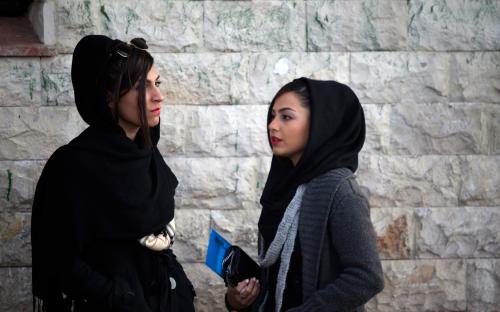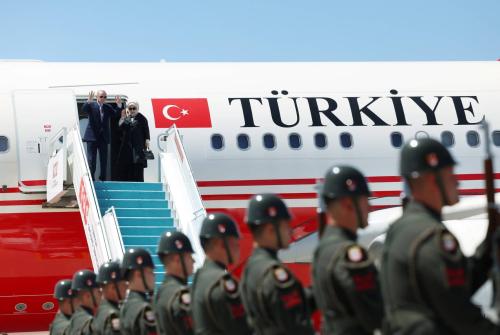This op-ed was originally published by The Hill.
The recent tightening of oil sanctions has revived speculation about their dire consequences for Iran’s economy.
The end to waivers for eight countries that under U.S. sanctions were allowed to import oil from Iran, announced last week, is sure to worsen the already bleak economic situation in Iran, but predictions of economic collapse are highly exaggerated.
If the revised International Monetary Fund (IMF) forecast of GDP growth for Iran, -6.0 percent, is to be believed, the impact from U.S. sanctions will be relatively moderate, alarmist reports notwithstanding.
This would be a smaller drop than that which European countries like Greece, Italy and Spain experienced after the 2008 global financial crisis. In this case, deep recession rather than economic collapse is a more accurate way to describe what Iran faces in the next year or two.
Iran’s economy depends heavily on oil. Although oil accounts for less than 20 percent of the GDP, in the absence of a plan to restructure the economy away from oil, its loss can be more serious that its share of GDP indicates.
Oil accounts for about half of all exports and 40 percent of government revenues. In the past 10 years, oil exports have averaged about $67 billion. Last year, they dropped by two-thirds, and they are expected to drop below $30 billion this year.
There are reasons to believe that, with appropriate policies, the country can live with this level of oil exports, albeit at a reduced standard of living, and even do itself some good in the long run by reducing its dependence on oil.
First, Iran has been there before. In 2012, when President Obama ratcheted up U.S. sanctions against Iran, oil exports dropped by 27.5 percent, and GDP fell by 6.2 percent. In 2015, sanctions and the collapse of oil prices further reduced oil exports to $32 billion, a decade-long low, and GDP declined by 1.6 percent.
The low impact on growth is because large sections of the economy, like services and agriculture, which together account for two-thirds of the GDP, are less dependent on foreign trade and are therefore more immune from sanctions.
Indeed, in 2012, when industrial production declined by 3.6 percent, services actually expanded (by 1 percent). Presumably, as devaluation made imported and import-dependent goods more expensive, consumers spent more on services.
Second, Iran does not have much foreign debt, so it does not have pressures from foreign lenders to contend with. Restructuring is most difficult when the public sees restructuring is to benefit foreign lenders.
A lesser known factor is that Iran’s economy is relatively diversified. Iran produces and exports more than just oil. It has a significant production base, from steel and cars to light manufacturing that, with the right incentives, can be restructured to shift jobs and production from import-intensive sectors to sectors that rely on domestic inputs.
These advantages do not mean, however, that adjusting to the shock, even a modest 6 percent, will be easy. Ironically, because Iran does not have the IMF and foreign lenders dictating how it should restructure its economy, finding the right plan and committing to it may be difficult.
The most important of these challenges is Iran’s highly fractured polity. Election after election has revealed a wide chasm between an educated, modern middle class and more traditional voters who support the hardline clergy.
In the latest round, in 2016, a significant majority (57 percent) voted to re-elect the moderate Hassan Rouhani for his promises to liberalize the economy and reduce Iran’s international isolation by reaching a deal with the West on the nuclear standoff.
Once President Trump withdrew the U.S. from the nuclear deal and re-imposed sanctions, far from closing ranks with Rouhani, hardliners seized the opportunity to derail his entire economic and political agenda.
Discord in the leadership of the Islamic Republic is the main reason for the gridlock that prevents ratification of the Financial Action Task Force (FATF), which is necessary for Iran’s banks to transact with the global banking system.
A second challenge is to restructure while maintaining fairness. This year, importers with access to heavily subsidized foreign exchange or those with goods to export have made substantial gains, while the tripling of welfare payments to the approximately 10 million poor people on the payroll of state agencies appears to have protected this group form the worst effects of the sanctions.
The main losers so far have been the salaried middle class and the retired workers, whose incomes have failed to keep pace with inflation. Last year, the 2.5 million strong government workforce did not get a raise while prices accelerated.
This year, with inflation expected to reach 40 percent, they have received a 20-percent raise, causing their real incomes to fall further by 20 percent. Little surprise, then, that protests and strikes by members of the largest block of government employees, the 600,000 teachers, have spread across the country.
If Iran’s leadership is to successfully resist U.S. demands, it must do more than find ways to evade sanctions. A lot depends on its ability to adopt a plan that reduces the economy’s dependence on oil, while distributing the burden of restructuring equitably across social groups.
The Brookings Institution is committed to quality, independence, and impact.
We are supported by a diverse array of funders. In line with our values and policies, each Brookings publication represents the sole views of its author(s).










Commentary
Op-edCan Iran weather the Trump storm?
May 3, 2019